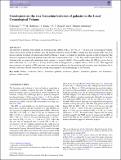Constraints on the star formation histories of galaxies in the Local Cosmological Volume
Abstract
The majority of galaxies with current star formation rates (SFRs), SFRo≥10−3M⊙yr−1, in the Local Cosmological Volume, where observations should be reliable, have the property that their observed SFRo is larger than their average SFR. This is in tension with the evolution of galaxies described by delayed-τ models, according to which the opposite would be expected. The tension is apparent in that local galaxies imply the star formation time-scale τ ≈ 6.7 Gyr, much longer than the 3.5–4.5 Gyr obtained using an empirically determined main sequence at several redshifts. Using models where the SFR is a power law in time of the form ∝(t − t1)η for t1 = 1.8 Gyr (with no stars forming prior to t1) implies that η = 0.18 ± 0.03. This suggested near-constancy of a galaxy’s SFR over time raises non-trivial problems for the evolution and formation time of galaxies, but is broadly consistent with the observed decreasing main sequence with increasing age of the Universe.
Citation
Kroupa , P , Haslbauer , M , Banik , I , Nagesh , S T & Pflamm-Altenburg , J 2020 , ' Constraints on the star formation histories of galaxies in the Local Cosmological Volume ' , Monthly Notices of the Royal Astronomical Society , vol. 497 , no. 1 , pp. 37-43 . https://doi.org/10.1093/mnras/staa1851
Publication
Monthly Notices of the Royal Astronomical Society
Status
Peer reviewed
ISSN
0035-8711Type
Journal article
Description
IB is supported by an Alexander von Humboldt postdoctoral research fellowship. PK acknowledges support from the Grant Agency of the Czech Republic under grant number 20-21855S. This work benefited from the International Space Science Institute (ISSI/ISSI-BJ) in Bern and Beijing, thanks to the funding of the team ‘Chemical abundances in the ISM: the litmus test of stellar IMF variations in galaxies across cosmic time’ (Donatella Romano and Zhi-Yu Zhang).Collections
Items in the St Andrews Research Repository are protected by copyright, with all rights reserved, unless otherwise indicated.
Related items
Showing items related by title, author, creator and subject.
-
SDSS-IV MaNGA: How the stellar populations of passive central galaxies depend on stellar and halo mass
Oyarzún, Grecco A.; Bundy, Kevin; Westfall, Kyle B.; Tinker, Jeremy L.; Belfiore, Francesco; Argudo-Fernández, Maria; Zheng, Zheng; Conroy, Charlie; Masters, Karen L.; Wake, David; Law, David R.; McDermid, Richard M.; Aragón-Salamanca, Alfonso; Parikh, Taniya; Yan, Renbin; Bershady, Matthew; Sánchez, Sebastián F.; Andrews, Brett H.; Fernández-Trincado, José G.; Lane, Richard R.; Bizyaev, D.; Boardman, Nicholas Fraser; Lacerna, Ivan; Brownstein, J. R.; Drory, Niv; Zhang, Kai (2022-07-06) - Journal articleWe analyze spatially resolved and co-added SDSS-IV MaNGA spectra with signal-to-noise ratio ∼100 from 2200 passive central galaxies (z ∼ 0.05) to understand how central galaxy assembly depends on stellar mass (M*) and halo ... -
Secular-and merger-built bulges in barred galaxies
Mendez Abreu, Jairo; Debattista, V. P.; Corsini, E. M.; Aguerri, J. A. L. (2014-12) - Journal articleContext. Historically, galaxy bulges were thought to be single-component objects at the center of galaxies. However, this picture is now questioned since different bulge types with different formation paths, namely classical ... -
Galaxy And Mass Assembly (GAMA) : galaxy close pairs, mergers and the future fate of stellar mass
Robotham, A. S. G.; Driver, S. P.; Davies, L. J. M.; Hopkins, A. M.; Baldry, I. K.; Agius, N. K.; Bauer, A. E.; Bland-Hawthorn, J.; Brough, S.; Brown, M. J. I.; Cluver, M.; De Propris, R.; Drinkwater, M. J.; Holwerda, B. W.; Kelvin, L. S.; Lara-Lopez, M. A.; Liske, J.; Lopez-Sanchez, A. R.; Loveday, J.; Mahajan, S.; McNaught-Roberts, T.; Moffett, A.; Norberg, P.; Obreschkow, D.; Owers, M. S.; Penny, S. J.; Pimbblet, K.; Prescott, M.; Taylor, E. N.; van Kampen, E.; Wilkins, S. M. (2014-11-11) - Journal articleWe use a highly complete subset of the Galaxy And Mass Assembly II (GAMA-II) redshift sample to fully describe the stellar mass dependence of close pairs and mergers between 10(8) and 10(12)M(circle dot). Using the analytic ...

